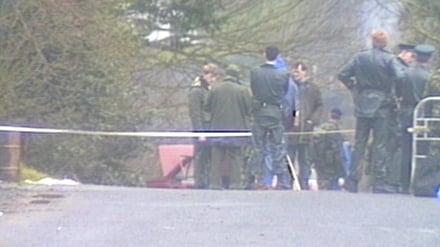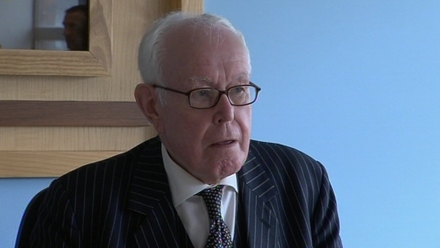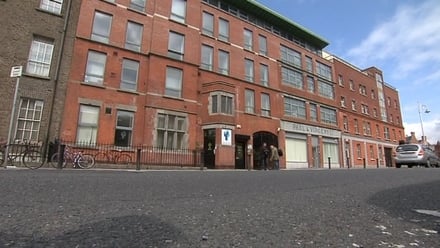 RTÉ North-East Correspondent Richard Dowling looks at the issues and individuals likely to dominate proceedings at the Smithwick Tribunal.
RTÉ North-East Correspondent Richard Dowling looks at the issues and individuals likely to dominate proceedings at the Smithwick Tribunal.
It could be a monstrous stain on the character of three men that has followed them through the years. Or it may be that one of them committed an act of treachery of a kind rarely, if ever, witnessed during the Troubles.
Perhaps the Smithwick Tribunal will finally reveal the truth.
The Tribunal was set up in 2005 to investigate claims that a garda or other Sate employee, either directly or by failing to act, colluded with the Provisional IRA in the murders of Chief Supt Harry Breen and Supt Bob Buchanan.
The opening address of the Tribunal has for the first time put into the public domain the identity of three gardaí whose names have for years been linked with the murders.
They are retired Detective Sergeant Owen Corrigan, retired Detective Sergeant Leo Colton and former Sergeant Finbarr Hickey.
They all worked in Dundalk at the time of the ambush in which the two most senior RUC officers to die in the Troubles, Harry Breen and Bob Buchanan, were murdered. None of them has ever been charged, let alone convicted of any offence linked to the deaths of the RUC men.
They are innocent and will remain so unless any one of them is convicted in a criminal court of a charge arising from the murders. The Smithwick Tribunal is not that court.

By the nature of its work, especially from those likely to be called to give evidence, Smithwick may also reveal far more than just what happened on 20 March 1989. Aspects of the so-called 'Dirty War' in Northern Ireland, in particular the role of agents, spies and their handlers in the British security forces, is also likely to be examined in some detail in relation to the murders.
The long standing rumour has been that a garda operating in Dundalk Garda Station tipped off the IRA that the two RUC men were at, or going to be, at a meeting there, allowing the Provisionals time to set up an ambush which led to the men’s deaths. A secondary rumour was that the telephone exchange in Dundalk was tapped by the IRA and that is how they became aware of the RUC men’s visit.
Early on the afternoon of 20 March 1989, the two senior RUC officers met in Newry Police Station and with Supt Buchanan driving, they headed south to Dundalk Garda Station. There they had a meeting with their counterparts about organising a joint operation targeting cross border smuggling and, in particular, well-known republican Thomas 'Slab' Murphy. They had travelled in Supt Buchanan's red Vauxhall Cavalier car, which he parked in the car park at the front of the garda station where it was visible to the public.
After the meeting, they returned to Northern Ireland and were driving along a narrow country road, the Edenappa Road near Jonesboro, when they approached what seemed to be an army checkpoint. However, as they got close, four to five men jumped out of the back of a van and started shooting.
They realised too late what was happening. Supt Buchanan tried to reverse the car down the road but was instead shot dead in the driver’s seat. Chief Supt Breen got out of the car and, apparently, tried to surrender. He was killed with a shot to the head.

The ambush point was well chosen as it could not be seen by any of the British army watchtowers in the area. The ambush gang and those who had set up the roadblock escaped. No-one has ever been charged in connection with the murders.
Within hours of the deaths, suggestions of a mole were dismissed by the then Garda Commissioner Eugene Crowley and RUC Chief Constable John Hermon without any investigation.
Over the following years, as rumours continued, there were a total of three separate internal garda investigations into the allegations – all of which rejected the claim.
Then as part of the Weston Park Agreement in 2001, retired Canadian judge Peter Cory looked at several controversial murders. He recommended further investigations of six, including the murders of Breen and Buchanan.
In April 2000, the then Minister for Justice, John O’Donoghue, told the Dáil that 'no tangible evidence' was uncovered to show there was collusion. He later added: 'I did not say no evidence was uncovered.'
Now, six years after the Tribunal was set up, we have got to the stage where the public are now starting to hear evidence. Over the coming weeks, and possibly months, the Tribunal will put before the judge and the public witnesses to give evidence as well as other material the investigative team believe is relevant, including intelligence material.
It has taken so long to get here because the Tribunal has been dogged by delays, disputes and considerable efforts to track down witnesses. The fact that the two murders were committed inside Northern Ireland, legally another jurisdiction, has made requesting records and witnesses even more difficult.

There has been much correspondence between the Tribunal and the Police Service of Northern Ireland, the British Ministry of Defence and the Northern Ireland Office regarding documents and witnesses.
However, as the Tribunal noted in its opening statement, information recently made available to them suggests that the 'British authorities' hold other relevant documents which the Tribunal has not been made aware of. It seems surprising that, years after first engaging with the different organisations, the Tribunal is still hearing about relevant information and then has to go and ask for it.
Dirty War
One of the more controversial aspects of the Tribunal will be its probe into the 'Dirty War', the covert operations by British security services both in Northern Ireland and the Republic.
This will be very much a side issue as it is not part of the core element of whether there was garda collusion with the PIRA in the murders.
However, it will feature as some of the key witnesses, who will allege there was collusion, also worked as spies within the PIRA for the British security services.
Just what they did as well as what they know will feature prominently in the coming weeks. Whether people like Ian Hurst, who uses the pseudonym 'Martin Ingram', will be allowed give evidence in open by his former bosses in the Ministry of Defence remains to be seen. He, along with 'Kevin Fulton', is well known having written books and appeared on television discussing their former roles.
Other, less known agents are also expected to attend and give evidence. They will be worth listening to.
It has also been pointed out that if all the intelligence reports are taken together, there were in fact five separate IRA moles operating within Dundalk Garda Station. That is pretty much impossible, but it does highlight the dangers of solely relying on intelligence reports, regardless of their source.

Witnesses
During its investigative phase, the Tribunal has interviewed 214 people - 107 of them were members or former members of the gardaí; 42 retired RUC officers or members of the PSNI and 65 'others'.
It is this last category that is most interesting. Although the Tribunal mentioned politicians and telecoms personnel, they did not mention other groups which included former members of the Provisional IRA who carried out the attack, as well as spies (or at least people who claim they were spies) who worked inside the PIRA for the British security services.
Among the many people who will give evidence before the Tribunal, a few stand out as crucial. Others certainly will be interesting, but whether they provide any new information remains to be seen.
The main characters in the Tribunal:
Retired Det Sgt Owen Corrigan: He denies all allegations of collusion. He worked as a garda in Dundalk and between the years 1963 to 1983 he received eight commendations.
He was named in British intelligence reports in 1985, which claimed he passed on information to the PIRA. Under Parliamentary Privilege, he was named by Jeffrey Donaldson MP as the mole.
In 1996, he was abducted by suspected members of the PIRA outside a Drogheda hotel together with another person who was, gardaí believe, an associate of subversives.
Two days later, Mr Corrigan turned up in Our Lady of Lourdes Hospital in Drogheda with injures. He refused to make a statement to gardaí about his abduction.
The Tribunal has also learned that there was a criminal prosecution against Mr Corrigan for seeking to obtain money by false pretences following a road accident.
The case did not go ahead when a prosecution witness failed to turn up. He won a libel action against Ireland on Sunday newspaper when it claimed he was the IRA mole.
Retired Det Sgt Leo Colton: Also denies any allegations of collusion. He joined the gardaí in 1958 and received five commendations during his service.
Mr Hickey claims he was asked by Mr Colton to sign eight passport forms which subsequently came into the hands of the Provisional IRA. No charges were ever made against Mr Colton and he denies the claim by Mr Hickey. He is the only former garda to be allowed two legal counsel at the Tribunal.
Former Sgt Finbarr Hickey: Was convicted at the Special Criminal Court in relation to the passports and was given a three-year prison sentence.
He too rejects claims of collusion. He joined the gardaí in late 1980 and was promoted to sergeant in February 1992. He received a favourable commendation for work in 1984.
Kevin Fulton/Peter Keeley: Originally from Newry, the former agent, who uses the pseudonym of Kevin Fulton, says he enlisted in the British army. Shortly after, he was recruited as an spy and sent back to Northern Ireland to work undercover within the Provisional IRA for MI5.
He claims that Owen Corrigan was the IRA mole. He may also claim that a well-known member of Sinn Féin was a British spy during the Troubles. His former wife has legal representatives watching the Tribunal.
She is suing the PSNI, the Ministry for Defence and Freddie Scappaticci for trauma claiming she was abducted by the IRA while her husband worked as an agent. She claims Mr Scappaticci carried out her questioning.
Martin Ingram/Ian Hurst: Now uses the pseudonym of Martin Ingram, but in a former career he worked inside the British army’s secretive Force Research Unit as an agent handler.
The FRU ran several agents during the Troubles, including several who participated in loyalist murder squads.
The FRU have been linked via an agent to the murder of solicitor, Pat Finucane. Hurst said he was willing to talk but High Court injunctions in the UK prevented him from doing so.
After years of protracted negotiations, the MoD allowed Mr Hurst to talk to the Tribunal. After more legal wrangling, the MoD has now allowed him to make a statement and he is also likely to give evidence although the MoD may insist that is done in private.
Freddie Scappaticci: A committed republican, Mr Scappaticci denies, however, that he was the British agent with the codename 'Stakeknife'.
This agent was one of if not the most highly prized British agent working within the Provisional IRA. He was a senior member of the IRA internal security unit known as the 'Nutting Squad’ but was also supplying information to his handlers.
It has also been claimed that other agents or individuals were sacrificed to protect his identity. Mr Scappaticci has been granted legal representation at the Tribunal. He is also being sued by Peter Keeley’s former wife, Margaret Keeley, who claims he interrogated her for the IRA.
Garda A: A former Garda Supt, as yet unnamed. While it's been well known that Chief Supt Breen expressed concern about Mr Corrigan, this garda will reveal for the first time that his colleague Supt Buchanan had also expressed concern about one of the three former gardaí being investigated by the Tribunal.
That was a year before the ambush and he says he told Garda Headquarters. Six months before the ambush he received intelligence about a threat to Supt Buchanan’s life. Again he passed the information to Garda HQ. The Tribunal will look at what happened to that information.
Provisional IRA Commanders: It was a surprise to hear that former members of the Provisional IRA leadership, both nationally and in South Armagh, had spoken to the Tribunal – including one who was involved directly in the ambush.
Their evidence will be put before the Tribunal but it remains to be seen if any of them will give direct evidence.
Alan Maines: Worked as a staff officer for Chief Supt Breen. He said that before Breen left for the fateful meeting in Dundalk, he expressed concern about having to travel to Dundalk because a garda there, whom he said was Owen Corrigan, was in the pay of Thomas 'Slab' Murphy, a local republican.
Richard Dowling

